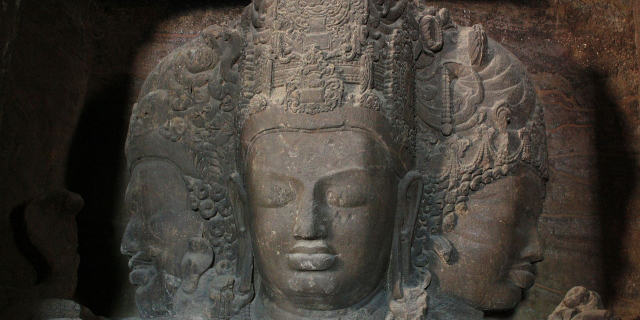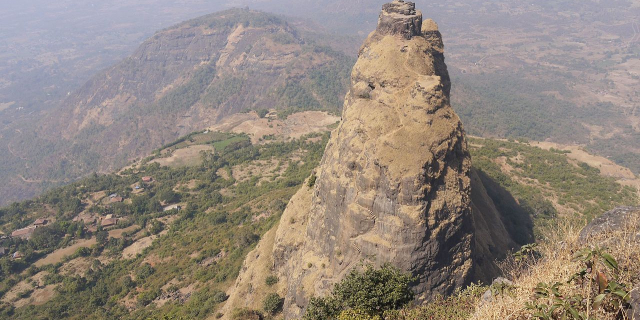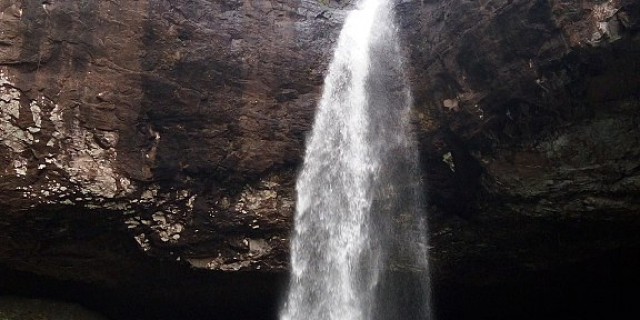The Elephanta Caves are a collection of cave temples predominantly dedicated to the Hindu god Shiva, which have been designated a UNESCO World Heritage Site. They are on Elephanta Island, or Gharapuri (literally meaning "the city of caves"), in Mumbai Harbour, 10 kilometres (6.2 mi) east of Mumbai in the Indian state of Mahārāshtra. The island, about 2 kilometres (1.2 mi) west of the Jawaharlal Nehru Port, consists of five Hindu caves, a few Buddhist stupa mounds that date back to the 2nd century BCE, and two Buddhist caves with water tanks.
The Elephanta Caves contain rock-cut stone sculptures, mostly in high relief, that show syncretism of Hindu and Buddhist ideas and iconography. The caves are hewn from solid basalt rock. Except for a few exceptions, much of the artwork is defaced and damaged. The main temple's orientation as well as the relative location of other temples are placed in a mandala pattern. The carvings narrate Hin...Read more
The Elephanta Caves are a collection of cave temples predominantly dedicated to the Hindu god Shiva, which have been designated a UNESCO World Heritage Site. They are on Elephanta Island, or Gharapuri (literally meaning "the city of caves"), in Mumbai Harbour, 10 kilometres (6.2 mi) east of Mumbai in the Indian state of Mahārāshtra. The island, about 2 kilometres (1.2 mi) west of the Jawaharlal Nehru Port, consists of five Hindu caves, a few Buddhist stupa mounds that date back to the 2nd century BCE, and two Buddhist caves with water tanks.
The Elephanta Caves contain rock-cut stone sculptures, mostly in high relief, that show syncretism of Hindu and Buddhist ideas and iconography. The caves are hewn from solid basalt rock. Except for a few exceptions, much of the artwork is defaced and damaged. The main temple's orientation as well as the relative location of other temples are placed in a mandala pattern. The carvings narrate Hindu mythologies, with the large monolithic 5.45 metres (17.9 ft) Trimurti Sadashiva (three-faced Shiva), Nataraja (Lord of dance) and Yogishvara (Lord of Yogis) being the most celebrated.
These date to between the 5th and 9th centuries, and scholars attribute them to various Hindu dynasties. They are most commonly placed between the 5th and 7th centuries. Many scholars consider them to have been completed by about 550 CE.
They were named Elefante—which morphed to Elephanta—by the colonial Portuguese who found elephant statues on the caves. They established a base on the island. The main cave (Cave 1, or the Great Cave) was a Hindu place of worship until the Portuguese arrived, whereupon the island ceased to be an active place of worship. The earliest attempts to prevent further damage to the caves were started by British India officials in 1909. The monuments were restored in the 1970s. It is currently maintained by the Archaeological Survey of India (ASI).
The ancient history of the island is unknown in both Hindu or Buddhist records. Archeological studies have uncovered many remains that suggest the small island had a rich cultural past, with evidence of human settlement by possibly the 2nd century BC.[1][2] The Elephanta site was first occupied by Hinayana Buddhists, before the arrival of the Brahmans to the island, to raise a large stupa to the Buddha with seven smaller stupas around it, probably around the 2nd century BCE.[3][4] Coins of the Kshatrapas (Western Satraps) dating to the 4th century CE were found on the island.[5] The regional history is first recorded in the Gupta Empire era, but these do not explicitly mention these caves.[2] This has made the origins and the century in which Elephanta caves were built a subject of a historic dispute. They have been variously dated, mostly between from late 5th to late 8th century AD, largely based on the dating of other cave temples in the Deccan region.[2] Colonial era historians suggested that the caves were built by the Rashtrakutas in 7th century or after, a hypothesis primarily based on some similarities with the Ellora Caves,[2] but this theory has been discredited by later findings.[6][7]
 Map of the Early Kalachuris circa 600 CE.[8]
Map of the Early Kalachuris circa 600 CE.[8]According to Archaeological Survey of India and UNESCO, the site was settled in ancient times and the cave temples were built between 5th and 6th century.[1][2] Contemporary scholars generally place the completion of the temples to the second quarter of the 6th century and as a continuation of the period of artistic flowering in the Gupta Empire era.[7][2][9] These scholars attribute these Cave temples to king Krishnaraja of the Kalachuri dynasty.[6][10] The dating to a mid 6th century completion and it being a predominantly Shiva monument built by a Hindu Kalachuri king is based on numismatic evidence, inscriptions, construction style and better dating of other Deccan cave temples including the Ajanta Caves, and the more firm dating of Dandin's Dasakumaracarita.[7][11][12]
According to Charles Collins, the significance of the Elephanta Caves is better understood by studying them in the context of ancient and early medieval Hindu literature, as well as in the context of other Buddhist, Hindu and Jain cave temples on the subcontinent. The historic Elephanta artwork was inspired by the mythology, concepts and spiritual ideas found in the Vedic texts on Rudra and later Shiva, the epics, the Puranas and the Pashupata Shaivism literature corpus of Hinduism composed by the 5th-century. The panels reflect the ideas and stories widely accepted and well known to the artists and cave architects of India by about 525 CE. The mythology varies significantly in these texts and has been much distorted by later interpolations, but the Elephanta Cave panels represent the narrative version most significant in the 6th century.[13][14] The panels and artwork express through their eclecticism, flux and motion the influence of Vedic and post-Vedic religious thought on Hindu culture in mid 1st millennium CE.[15]
After the caves' completion in the 6th century, Elephanta became popular regionally as Gharapuri (village of caves). The name is still used in the local Marathi language.[16] It became a part of the Gujarat Sultanate rulers, who ceded it to the Portuguese merchants in 1534. The Portuguese named the island "Elephanta Island" for the huge rock-cut stone statue of an elephant, the spot they used for docking their boats and as a landmark to distinguish it from other islands near Mumbai. The elephant statue was damaged in attempts to relocate it to England, was moved to the Victoria Gardens in 1864, was reassembled in 1914 by Cadell and Hewett, and now sits in the Jijamata Udyaan in Mumbai.[17][18][19]


Scholars are divided on who most defaced and damaged the Elephanta Caves. According to Macneil, the monuments and caves were already desecrated during the Sultanate rule, basing his findings on the Persian inscription on a door the leads to the grand cave.[16] In contrast, others such as Ovington and Pyke, link the greater damage to be from the Christian Portuguese soldiers and their texts which state they used the caves and statues as a firing range and for target practice.[16][20][21]
Macneil concurs that Elephanta Caves were defaced and damaged during the colonial period, but assigns the responsibility not to the soldiers but to the Portuguese authorities.[16] The colonial era British publications state they were "defaced by the zeal of Mahommedans and Portuguese".[17]
The Portuguese ceded the island in 1661 to the colonial British, but by then the Caves had seen considerable damage. The Portuguese had also removed and then lost an inscription stone from the caves.[22][23] During the British rule, many Europeans visited the caves during their visit to Bombay, then published their impressions and memoirs. Some criticised it as having "nothing of beauty or art", while some called it "enormous artwork, of extraordinary genius".[21]
The British relied on the port city of Bombay (now Mumbai), which led to it becoming a major urban centre and the migration of Hindus looking for economic opportunities. The Elephanta caves re-emerged as a centre of Hindu worship, and according to British administration records, the government charged the pilgrims a temple tax at least since 1872.[citation needed]
In 1903, the Hindus petitioned the government to waive this fee, which the British agreed to on three Shiva festival days if Hindus agreed. The Elephants Caves were, otherwise, left in its ruinous condition.[24]


In the late 1970s, the Government of India restored the main cave in its attempt to make it a tourist and heritage site. The caves were designated a UNESCO World Heritage Site in 1987 as per the cultural criteria of UNESCO: the caves "represent a masterpiece of human creative genius" and "bear a unique or at least exceptional testimony to a cultural tradition or to a civilisation which is living or which has disappeared."[1]




























Add new comment